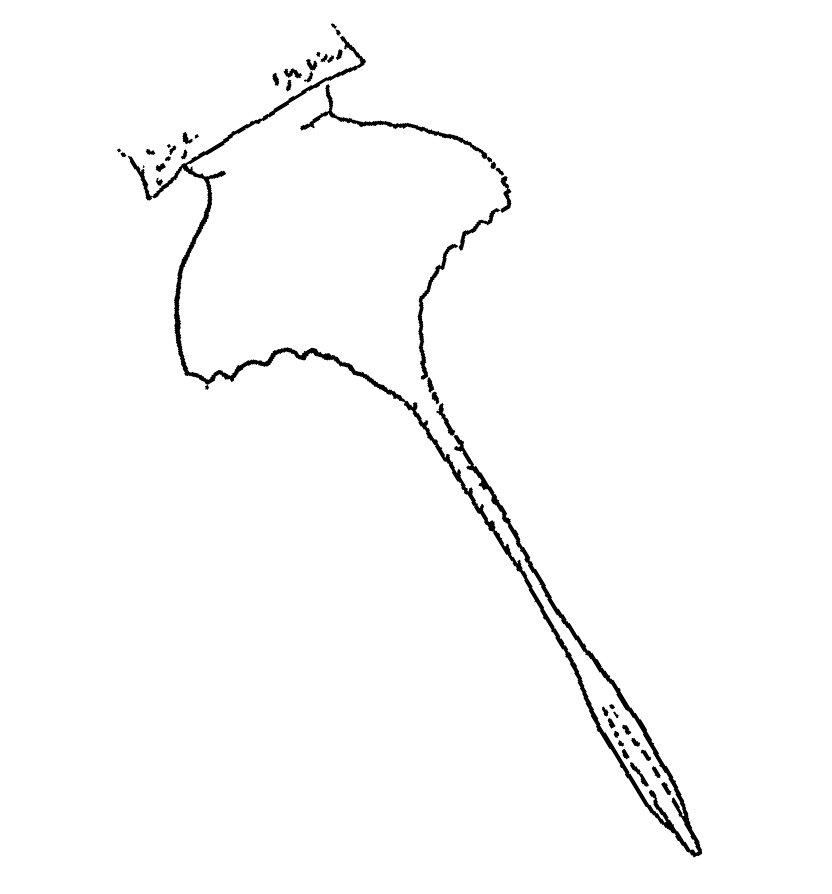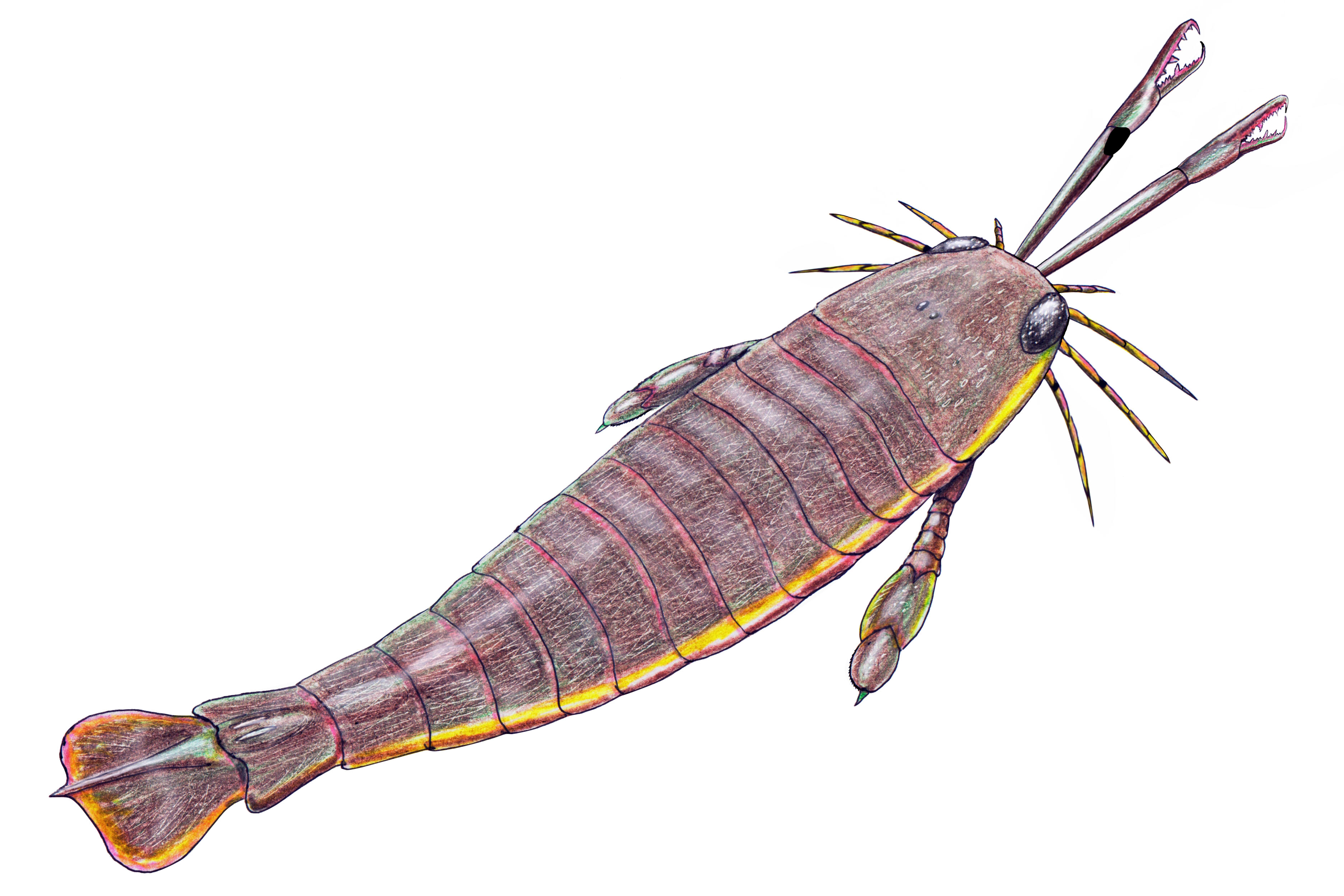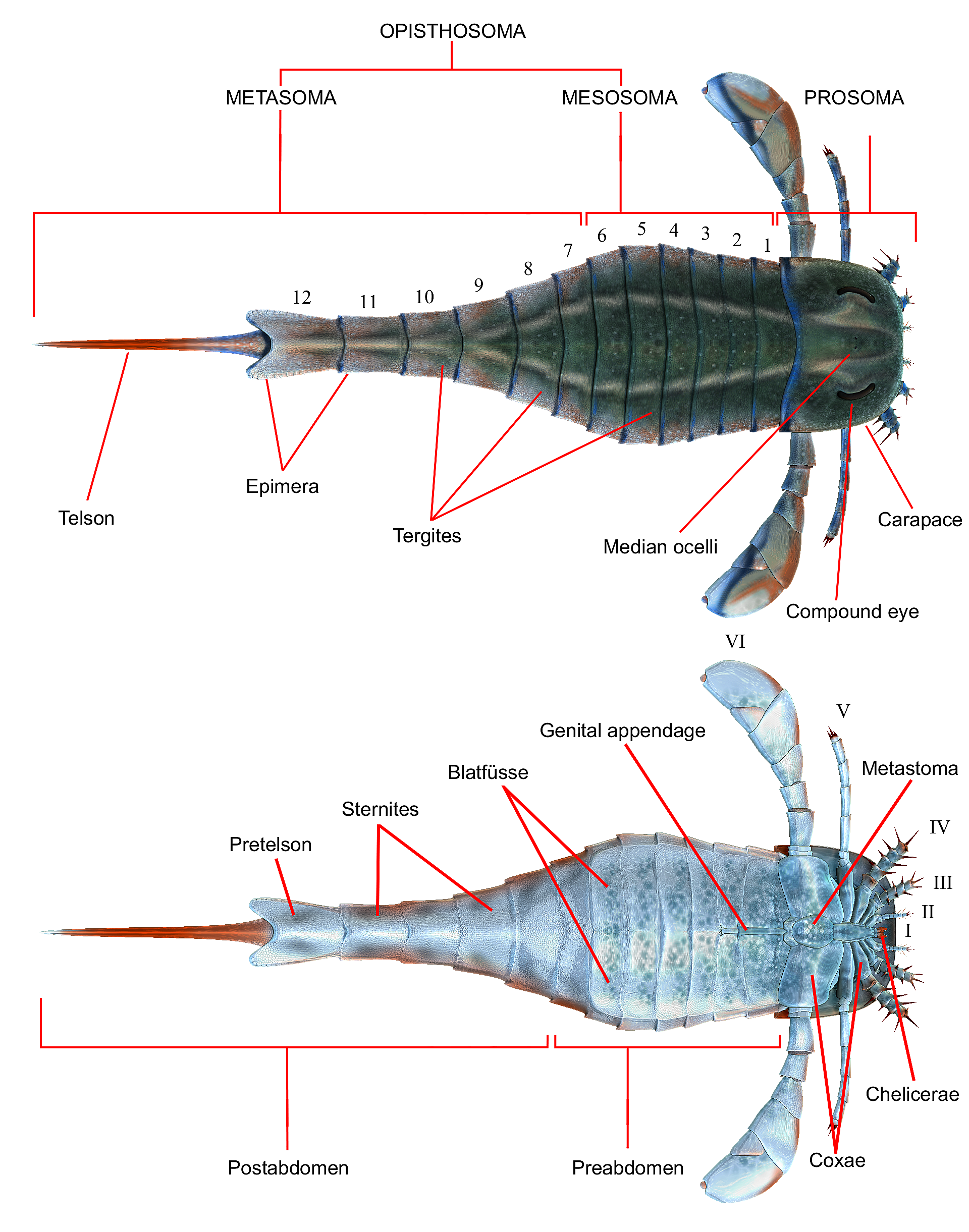|
Slimonidae
Slimonidae (the name deriving from the type genus '' Slimonia'', which is named in honor of Welsh fossil collector and surgeon Robert Slimon) is a family of eurypterids, an extinct group of aquatic arthropods. Slimonids were members of the superfamily Pterygotioidea and the family most closely related to the derived pterygotid eurypterids, which are famous for their cheliceral claws and great size. Many characteristics of the Slimonidae, such as their flattened and expanded telsons (the posteriormost division of their bodies), support a close relationship between the two groups. Slimonids are defined as pterygotioid eurypterids with swimming legs similar to those of the type genus, ''Slimonia'', and the second to fifth pair of appendages being non-spiniferous. The family contains only two genera, the almost completely known ''Slimonia'' and '' Salteropterus'', which is known only from the telson and the metastoma (a large plate part of the abdomen). Both slimonid genera preserv ... [...More Info...] [...Related Items...] OR: [Wikipedia] [Google] [Baidu] |
Pterygotioidea
Pterygotioidea (the name deriving from the type genus ''Pterygotus'', meaning "winged one") is a superfamily of eurypterids, an extinct group of aquatic arthropods. Pterygotioids were the most derived members of the infraorder Diploperculata and the sister group of the adelophthalmoid eurypterids. The group includes the basal and small hughmilleriids, the larger and specialized slimonids and the famous pterygotids which were equipped with robust and powerful cheliceral claws. Though the more primitive hughmilleriids were small, '' Hughmilleria wangi'' being the smallest of all pterygotioids at just in length, later members of the group, particularly in the Pterygotidae, would become the largest known arthropods to ever exist with several genera surpassing in length. Among all currently recognized eurypterid clades, the Pterygotioidea is the most diverse, containing over 50 species in 10 genera. With the number of recognized eurypterid species being around 250, pterygotio ... [...More Info...] [...Related Items...] OR: [Wikipedia] [Google] [Baidu] |
Hughmilleriidae
Hughmilleriidae (the name deriving from the type genus '' Hughmilleria'', which is named in honor of Scottish geologist Hugh Miller) is a family of eurypterids, an extinct group of aquatic arthropods. The hughmilleriids were the most basal members of the superfamily Pterygotioidea, in contrast with the more derived (more "advanced") families Pterygotidae and Slimonidae. Despite their classification as pterygotioids, the hughmilleriids possessed several characteristics shared with other eurypterid groups, such as the lanceolate telson (the most posterior segment of the body). Hughmilleriids are defined as pterygotioid eurypterids with swimming legs similar to those of the type genus, ''Hughmilleria'' (that is, 7th and 8th leg segments narrow and 9th segment very small), and whose second to fifth pair of appendages were spiniferous. Some further diagnostic characters unite the group, such as the slightly enlarged chelicerae (frontal appendages) and the streamlined shape of their b ... [...More Info...] [...Related Items...] OR: [Wikipedia] [Google] [Baidu] |
Slimonia Acuminata
''Slimonia'' is a genus of eurypterid, an extinct group of aquatic arthropods. Fossils of ''Slimonia'' have been discovered in deposits of Silurian age in South America and Europe. Classified as part of the family Slimonidae alongside the related '' Salteropterus'', the genus contains three valid species, ''S. acuminata'' from Lesmahagow, Scotland, ''S. boliviana'' from Cochabamba, Bolivia and ''S. dubia'' from the Pentland Hills of Scotland and one dubious species, ''S. stylops'', from Herefordshire, England. The generic name is derived from and honors Robert Slimon, a fossil collector and surgeon from Lesmahagow. Out of the four described species of ''Slimonia'', three measured below or up to in length. Only ''S. acuminata'' was larger, with the largest specimens measuring in length. Though this is large for a predatory arthropod, ''Slimonia'' would be exceeded in length by later and more derived (more "advanced") members of the closely related pterygotid family of eurypteri ... [...More Info...] [...Related Items...] OR: [Wikipedia] [Google] [Baidu] |
Salteropterus
''Salteropterus'' is a genus of eurypterid, an extinct group of aquatic arthropods. Fossils of ''Salteropterus'' have been discovered in deposits of Late Silurian age in Great Britain, Britain. Classified as part of the family Slimonidae, the genus contains one known valid species, ''S. abbreviatus'', which is known from fossils discovered in Herefordshire, England, and a dubious species, ''S. longilabium'', with fossils discovered in Leintwardine Beds, Leintwardine, also in Herefordshire. The generic name honours John William Salter, who originally described ''S. abbreviatus'' as a species of ''Eurypterus'' in 1859. ''Salteropterus'' is assumed to have been quite similar to its close relative ''Slimonia'', but the fragmentary nature of the fossil remains of ''Salteropterus'' make direct comparisons difficult. ''Salteropterus'' does however preserve a highly distinctive telson (the posteriormost division of the body) unlike any other in the Eurypterida. Beginning with an expanded ... [...More Info...] [...Related Items...] OR: [Wikipedia] [Google] [Baidu] |
Slimonia
''Slimonia'' is a genus of eurypterid, an extinct group of aquatic arthropods. Fossils of ''Slimonia'' have been discovered in deposits of Silurian age in South America and Europe. Classified as part of the family Slimonidae alongside the related ''Salteropterus'', the genus contains three valid species, ''S. acuminata'' from Lesmahagow, Scotland, ''S. boliviana'' from Cochabamba, Bolivia and ''S. dubia'' from the Pentland Hills of Scotland and one dubious species, ''S. stylops'', from Herefordshire, England. The generic name is derived from and honors Robert Slimon, a fossil collector and surgeon from Lesmahagow. Out of the four described species of ''Slimonia'', three measured below or up to in length. Only ''S. acuminata'' was larger, with the largest specimens measuring in length. Though this is large for a predatory arthropod, ''Slimonia'' would be exceeded in length by later and more derived (more "advanced") members of the closely related pterygotid family of eurypterid ... [...More Info...] [...Related Items...] OR: [Wikipedia] [Google] [Baidu] |
Slimonia Acuminata Reconstruction
''Slimonia'' is a genus of eurypterid, an extinct group of aquatic arthropods. Fossils of ''Slimonia'' have been discovered in deposits of Silurian age in South America and Europe. Classified as part of the family Slimonidae alongside the related ''Salteropterus'', the genus contains three valid species, ''S. acuminata'' from Lesmahagow, Scotland, ''S. boliviana'' from Cochabamba, Bolivia and ''S. dubia'' from the Pentland Hills of Scotland and one dubious species, ''S. stylops'', from Herefordshire, England. The generic name is derived from and honors Robert Slimon, a fossil collector and surgeon from Lesmahagow. Out of the four described species of ''Slimonia'', three measured below or up to in length. Only ''S. acuminata'' was larger, with the largest specimens measuring in length. Though this is large for a predatory arthropod, ''Slimonia'' would be exceeded in length by later and more derived (more "advanced") members of the closely related pterygotid family of eurypterid ... [...More Info...] [...Related Items...] OR: [Wikipedia] [Google] [Baidu] |
Pterygotidae
Pterygotidae (the name deriving from the type genus ''Pterygotus'', meaning "winged one") is a family of eurypterids, an extinct group of aquatic arthropods. They were members of the superfamily Pterygotioidea. Pterygotids were the largest known arthropods to have ever lived with some members of the family, such as ''Jaekelopterus'' and '' Acutiramus'', exceeding 2 metres (6.6 ft) in length. Their fossilized remains have been recovered in deposits ranging in age from 428 to 372 million years old ( Late Silurian to Late Devonian). One of the most successful groups of eurypterids, the pterygotids were the only eurypterid family to achieve a truly worldwide distribution. Several evolutionary innovations made the pterygotids unique among the eurypterids, with large and flattened telsons (the posteriormost division of the body) likely used as rudders to provide additional agility and enlarged chelicerae (frontal appendages) with claws. These claws were robust and possessed tee ... [...More Info...] [...Related Items...] OR: [Wikipedia] [Google] [Baidu] |
Eurypterid
Eurypterids, often informally called sea scorpions, are a group of extinct arthropods that form the Order (biology), order Eurypterida. The earliest known eurypterids date to the Darriwilian stage of the Ordovician period 467.3 Myr, million years ago. The group is likely to have appeared first either during the Early Ordovician or Late Cambrian period. With approximately 250 species, the Eurypterida is the most diverse Paleozoic Chelicerata, chelicerate order. Following their appearance during the Ordovician, eurypterids became major components of marine faunas during the Silurian, from which the majority of eurypterid species have been described. The Silurian genus ''Eurypterus'' accounts for more than 90% of all known eurypterid specimens. Though the group continued to diversify during the subsequent Devonian period, the eurypterids were heavily affected by the Late Devonian extinction event. They declined in numbers and diversity until becoming extinct during the Permian–Tri ... [...More Info...] [...Related Items...] OR: [Wikipedia] [Google] [Baidu] |
Chitin
Chitin ( C8 H13 O5 N)n ( ) is a long-chain polymer of ''N''-acetylglucosamine, an amide derivative of glucose. Chitin is probably the second most abundant polysaccharide in nature (behind only cellulose); an estimated 1 billion tons of chitin are produced each year in the biosphere. It is a primary component of cell walls in fungi (especially basidiomycetes and filamentous fungi), the exoskeletons of arthropods such as crustaceans and insects, the radulae, cephalopod beaks and gladii of molluscs and in some nematodes and diatoms. It is also synthesised by at least some fish and lissamphibians. Commercially, chitin is extracted from the shells of crabs, shrimps, shellfishes and lobsters, which are major by-products of the seafood industry. The structure of chitin is comparable to cellulose, forming crystalline nanofibrils or whiskers. It is functionally comparable to the protein keratin. Chitin has proved useful for several medicinal, industrial and biotechnological purpos ... [...More Info...] [...Related Items...] OR: [Wikipedia] [Google] [Baidu] |
Tagmata (arthropod Anatomy)
In biology, a tagma (Greek: τάγμα, plural tagmata – τάγματα - body of soldiers; battalion) is a specialized grouping of multiple segments or metameres into a coherently functional morphological unit. Familiar examples are the head, the thorax, and the abdomen of insects. The segments within a tagma may be either fused (such as in the head of an insect) or so jointed as to be independently moveable (such as in the abdomen of most insects). Usually the term is taken to refer to tagmata in the morphology of members of the phylum Arthropoda, but it applies equally validly in other phyla, such as the Chordata. In a given taxon the names assigned to particular tagmata are in some sense informal and arbitrary; for example, not all the tagmata of species within a given subphylum of the Arthropoda are homologous to those of species in other subphyla; for one thing they do not all comprise corresponding somites, and for another, not all the tagmata have closely analogous f ... [...More Info...] [...Related Items...] OR: [Wikipedia] [Google] [Baidu] |
Prosoma
The cephalothorax, also called prosoma in some groups, is a tagma of various arthropods, comprising the head and the thorax fused together, as distinct from the abdomen behind. (The terms ''prosoma'' and ''opisthosoma'' are equivalent to ''cephalothorax'' and ''abdomen'' in some groups.) The word ''cephalothorax'' is derived from the Greek words for head (, ') and thorax (, '). This fusion of the head and thorax is seen in chelicerates and crustaceans; in other groups, such as the Hexapoda (including insects), the head remains free of the thorax. In horseshoe crabs and many crustaceans, a hard shell called the carapace covers the cephalothorax. Arachnid anatomy Fovea The fovea is the centre of the cephalothorax and is located behind the head (only in spiders).Dalton, Steve (2008). ''Spiders; The Ultimate Predators''. A & C Black, London. P.p. 19. . It is often important in identification. It can be transverse or procurved Smith, A. M. (1990c). Baboon spiders: Tarantulas of Afr ... [...More Info...] [...Related Items...] OR: [Wikipedia] [Google] [Baidu] |
Silurian
The Silurian ( ) is a geologic period and system spanning 24.6 million years from the end of the Ordovician Period, at million years ago ( Mya), to the beginning of the Devonian Period, Mya. The Silurian is the shortest period of the Paleozoic Era. As with other geologic periods, the rock beds that define the period's start and end are well identified, but the exact dates are uncertain by a few million years. The base of the Silurian is set at a series of major Ordovician–Silurian extinction events when up to 60% of marine genera were wiped out. One important event in this period was the initial establishment of terrestrial life in what is known as the Silurian-Devonian Terrestrial Revolution: vascular plants emerged from more primitive land plants, dikaryan fungi started expanding and diversifying along with glomeromycotan fungi, and three groups of arthropods (myriapods, arachnids and hexapods) became fully terrestrialized. A significant evolutionary milestone during ... [...More Info...] [...Related Items...] OR: [Wikipedia] [Google] [Baidu] |








